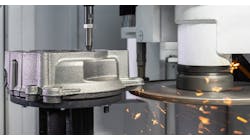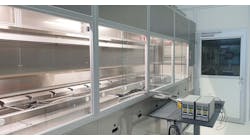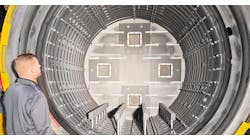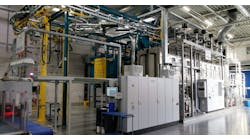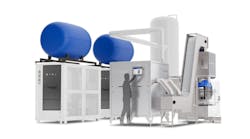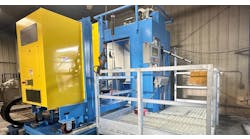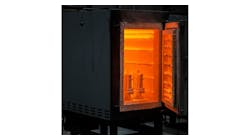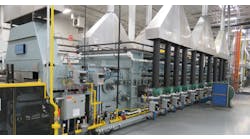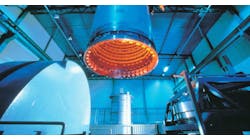Each day, the typical shop likely has some form of automation on the floor, but grinding and welding tend to remain manual processes, due to cost, product mix, or the perceived complexity of automating. Often tedious but always necessary, grinding can slow throughput in manual operations for many reasons. You aren’t always sure how long it will take workers to bring up a consistent, quality finish. And in today’s tight labor market, you don’t always have the staff available to take the time to do this and make sure it’s done right.
As businesses face the challenge of finding and retaining labor for these manual tasks, automating a grinding process has become increasingly relevant to manufacturers.
Before you say, “Wait! My shop isn’t big enough for automation,” or “I don’t have the right parts-mix to make this kind of investment,” take a look at why you should consider robotic processing, particularly an installation that is cost-effective and pre-engineered.
Pre-engineered robotic grinding cells streamline manufacturing production processes in operations that weld small-to medium-sized parts. They install and set-up easily with a single-base design that includes integrated features that deliver optimal performance, safety and quality with every grind.
The robotic advantage
Determining if you need to automate your grinding process can be challenging as no two shops work exactly alike and multiple factors drive this decision. However, robotic grinding delivers viable solutions for many manufacturers in these areas:
• Addressing labor shortages
• Increasing throughput
• Improving quality and consistency
• Mitigating safety concerns
In today’s competitive industrial market, consistent throughput is necessary. A pre-engineered robotic grinding solution will help you produce more parts and keep lines running because it’s often faster and more consistent than manual efforts.
There are various factors to consider, such as workholding, part positioning, and others; but robotic weld grinding can typically remove 80-90% of weld on a part. This results in less processing time. Robots are consistent and do the same thing every time, which greatly lowers the chance for error, rework and scrap. Automation helps provide uniform results.Furthermore, you can do this with fewer people on the floor. Automated grinding allows you to distribute your workforce better and keep your lines moving without needing to find more qualified operators. In turn, this contributes to better throughput, as you don’t have to shut down lines because you don’t have enough workers.
Robotic finishing allows you to increase productivity by having operators do other tasks, such as loading and unloading another automated welding or grinding system. Robots never get tired and can keep working until you shut them down.
With regard to safety concerns, manual grinding presents challenges related to air quality and harmful particulate matter, along with worker comfort and safety from noise and vibration. Possible hazards include vibrations and sparks.
Manual grinding also comes with deviation that can cause ergonomic strain for workers, potentially slowing production speeds and leaving inconsistent results from person to person and machine to machine. Automation avoids this, helping to deliver greater consistency and improved results because robots can be programmed to provide the same grind on the same part every time. Also, robotic grinding helps reduces worker fatigue and the need for rework.
Robotic integration success factors
To achieve any of these benefits, first look carefully at your operations and the kinds of abrasive applications you use. Think about the status of the incoming parts, initial welds, surface finish and consistency, and the geometric targets you’ve set.
Also consider the quality requirements of the finished product. What does the final, fully finished part need to look like and achieve? Stainless steel parts are very dependent on aesthetics but also may require a certain surface roughness for quality control. Or perhaps you’re removing welds for an application that is covered with paint or a powder coat. In this case, the grinding scratches just need to be refined enough to be covered by the paint. Often, the type of grinding you do and the abrasives you use in an automated system will vary from what you use in traditional manual processing.
Each application will vary, but you cannot go wrong in considering these six factors as you evaluate a robotic grinding installation.
1. Part throughput. You must ensure that that robot stays as busy as possible. This doesn’t always mean more parts; in many cases you can take linear inches of parts into account. More inches mean more time at the robot. If you’re running a series of boxes with many external seams that need to be finished, it may not require a high number of parts to keep the robotic line running steadily.
2. Part mix. This is a crucial decision factor. A family of like parts is a suitable candidate for robotic grinding. Let’s say you have boxes of the same shape but changing dimensions. This will work well because you don’t need to use special or changeout tooling to fixture these parts in the cell- an an ideal scenario for automated grinding.
3. Incoming part variability. Robotic systems fare best with consistent parts. Consistency sets things up perfectly for this automated process. Let’s say you have parts that are CNC lasered, then go to a CNC press brake and then ideally move into a robotic welding system. This sets up nicely for finishing with a robotic grinding system.
4. Finished part specifications. For some parts, the only objective might be removing the appearance of a welded corner so paint, powder-coat or black-oxide finishes adhere well to the substrate around a small radius. Robotic grinding is great for this kind of application. Sometimes, in instances where you need to grind a part to a specific dimension, you might find using robotic grinding difficult to hold tolerance, but it is possible with customized programming.
5. Part complexity. The easiest parts for robotic grinding again go back to our box example. The robot likes long linear surfaces they can easily traverse between the start and stop points. When using an automated grinding solution, you’ll quickly discover how tough it can be to program the system for abstract shapes. You can supplement this with targeted offline programming. Plus, the less time you have parts in an operator’s hands, the less chance you’ll have of the ergonomic impacts this process can cause. This helps keep workers on the line and not out with injuries and strain.
6. Number of abrasive steps. Maybe you need only one fixed grit for every part you finish. Or, perhaps, you have a set process of abrasion you need to follow, such as removing the bulk of the material with a 36 disc and then coming through with another abrasive designed to shine it up. Again, simpler is better for automation, but you can find success with different programming steps if needed.
As you consider these factors along with your processes and needs, be aware that it’s rare to have a candidate that address each one and appears to be a strong candidate. There can be a lot of gray areas in deciding what parts to grind with a robot.
For example, you could have a higher part mix but simple finished part specifications. Even though your parts are different shapes and sizes, they all have linear welds that are the same. While it’s a more challenging candidate, you shouldn’t rule it out. With some upfront programming, you could still get strong results.Looking at different welds and automated grinding
Are the welded parts good candidates for automated finishing? Some welds are more adaptable to robotic grinding than others. Let’s look at a few common welds and how they stack up as automated processing candidates.
Corner welds. Look at how much weld is there and how much needs to be removed. Also, consider your finishing requirements. Do you need to achieve a rounded radius? Or does the application require the corner to be a sharp 90°? Exterior corner welds are much easier to access and finish with a wide range of abrasives than those on the interior. Interior fillet welds and right-angle products are tough to access with a robotic system and can create side-loading issues and excess wear on abrasives. Exterior corner welds are a great candidate for robotic grinding.
Groove welds. As with any part, consider the finish requirement. With groove welds, you also have to consider the groove depth after the weld has been placed. Sometimes the joint fit-up on your parts won’t be perfect. Remember that the robot’s programmed feed rate isn’t going to change from part to part and so you might end up with some undercutting. When this happens, the media disc will come across the surface and take out much more material, sometimes as wide as the wheel to ensure proper finishing. In order to account for this, you’ll need to program the robot for consistent height upstream.
T-joint welds. When finishing these welds, you should side-load the wheel to minimize weld appearance and provide a smooth internal radius. This can be pretty tricky to do with a robotic system. Any fillet weld is difficult to process automatically and particularly so when fully blending a radius. It’s possible to do it, but consider staying with manual processing.
Flare-bevel welds. Parts with this type of welding often have recessed welds that may present challenges, meaning you will be trying to flatten and remove the appearance of one of these welds between two parent materials; this may take multiple steps to achieve. Protruding welds are more accessible and easier to address with automated processing.
Lap welds. Fit-up of these welds is a huge consideration when you’re deciding to automate grinding. While they’re linear welds, which in theory work well with robotic grinding, they also tend to have uneven surfaces. But, if the unevenness is consistent across parts, such as the same side always being higher, you can work this into programming and optimize the finishing requirements.
Automation is within reach
As you review all these considerations, you’ll likely discover that robotic finishing isn’t out of reach for your operation.
Automated finishing technology today is more agile and flexible. New, pre-engineered, all-in-one robotic grinding systems make automation accessible to shops of all sizes and all parts. Robotic grinding can supplement a lean workforce, deliver faster throughput with higher quality results with an eye of safety, ergonomics, and compliance.
Ryan Scott is a Business Development Project Manager at Lincoln Electric Automation. Contact him at [email protected].
Tyler Naatz is a Robotic Application Engineer at 3M Abrasive Systems Division. Contact him at [email protected].
